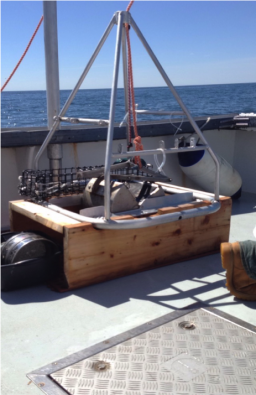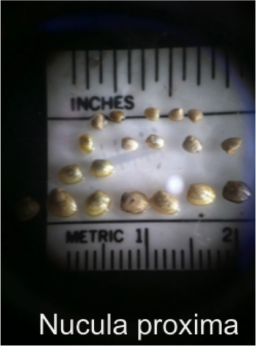Assessing Impacts of Climate Change on Gulf of Maine’s Bivalve Population
By Tom Porter
For Alana Luzzio ’17 the summer months brought with them an opportunity to continue her interest in mapping the ocean floor along the Maine coast. As an outgrowth of her previous work interning with the Maine Coastal Mapping Initiative, a state-run program which is collecting and analyzing data from the seabed, Luzzio has been looking at genetic variation among bivalves in the Gulf of Maine.
In a position funded by a grant from the Maine Outdoor Heritage Fund, she served for the second summer running as Benthic Intern at the state’s Department of Agriculture, Conservation and Forestry. The term “benthic,” she explained, refers to the ocean floor, and her work involved grabbing samples from the seabed including any organisms living there. “These included bivalves—in this case clams—marine worms, and amphipods, which are a type of crustacean related to shrimps and lobsters.” The sampling kit, said Luzzio, also has a seawater chemistry detection unit attached to it which measures things like temperature, salinity, pH levels, dissolved oxygen, and depth, as it descends.
Luzzio, who is majoring in biology and environmental studies, said as she moved from one location to another, she noticed variation. “When I was analyzing the benthic grab samples, there seemed to be site-to-site differences in the species composition of the bivalve community and the substrates in which they were found.” The bivalves she sampled, said Luzzio, act as a so-called sentinel species, meaning they provide indications or warnings of alarming changes in the chemistry of the environment. Considering also the economic importance of some clam species, Luzzio said it seemed the subject merited further study, which is what brought her to this summer research. “I initiated a project to look at the distribution and abundance of various bivalves from the samples, and isolated the most abundant species: Nucula proxima, which is a small bivalve known as the Atlantic nut clam, Ennucula tenuis, another type of clam, and Arctica islandica, or ocean quahog.”

She decided to study the genetic variation of these species. “The genetic analysis can assess if there is correlation between genotypic variation in the bivalve populations, and the natural environmental variation in measured water chemistry.” To that end, Luzzio collected 189 DNA samples and sent them off for next-generation sequencing. This should provide important data for scientists to study.
Luzzio was drawn to this project, she said, because the issue of genetic variation in bivalves and how that interacts with the variation in the chemical properties of their habitat, is “extremely pertinent: The Gulf of Maine is one body of water that is projected to be impacted heavily, and negatively, over the next 100 years due to climate change.” Investigating how the genetic make-up of bivalves is affected by the environment, she said, will enable scientists to draw important conclusions about how these populations could be further impacted in the future.



